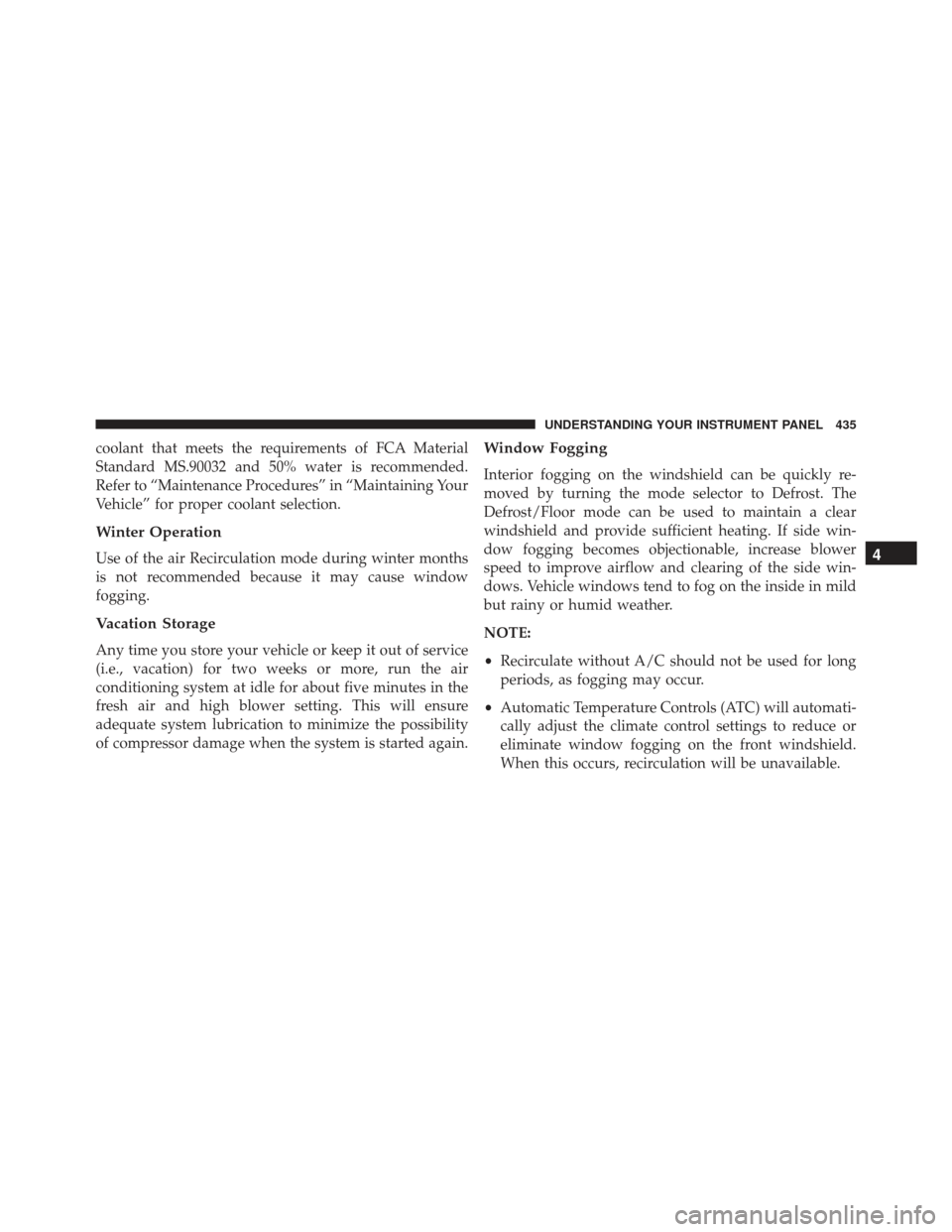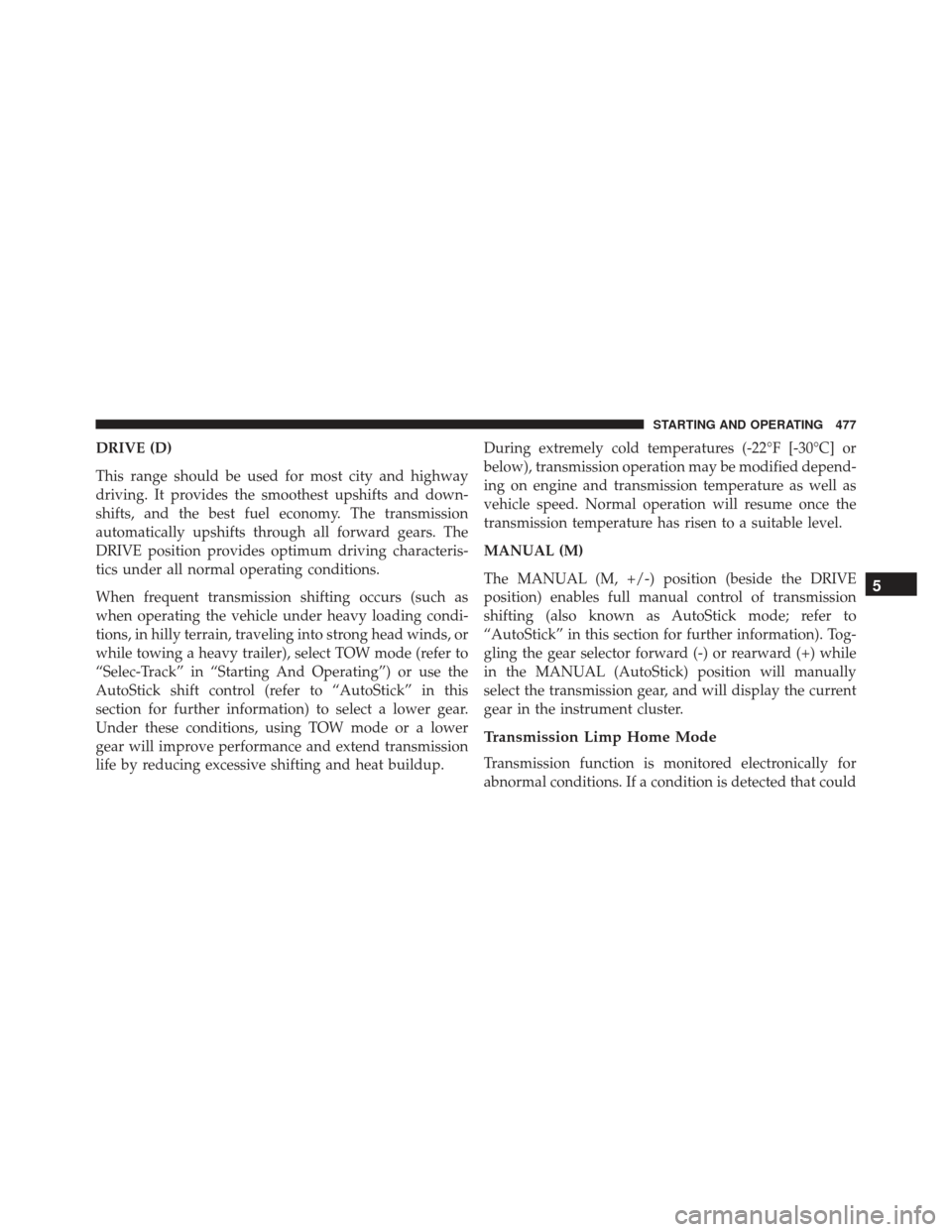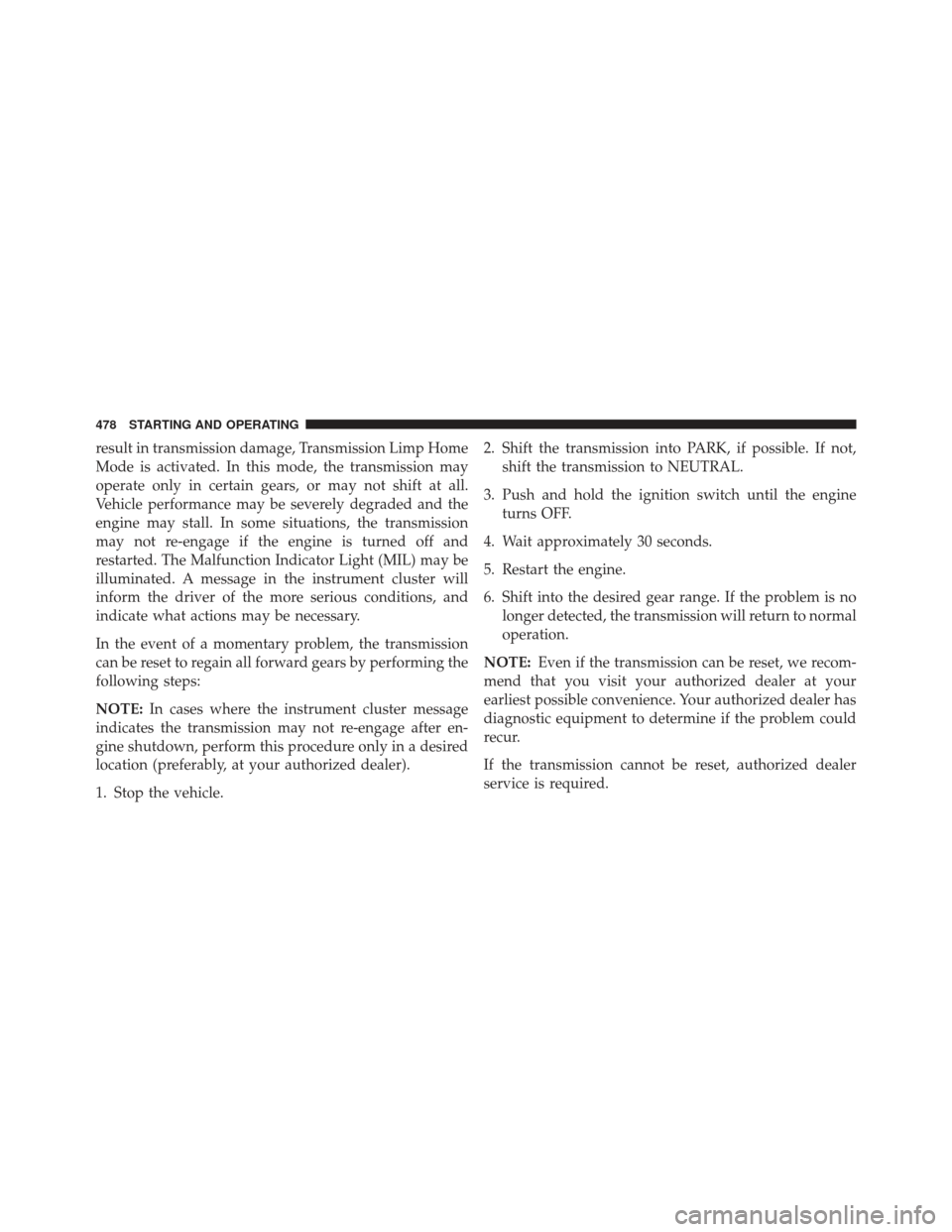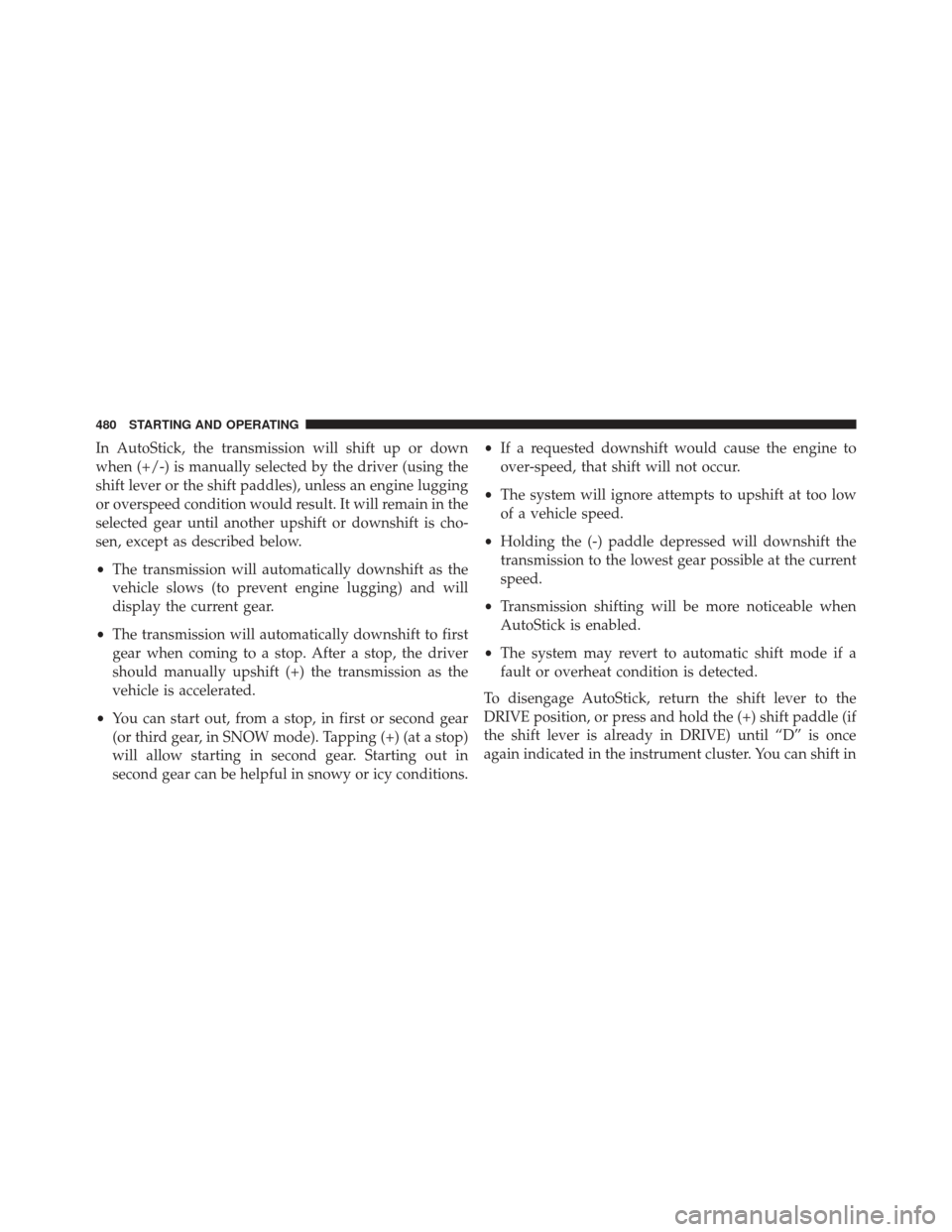Page 434 of 723
behind the radiator and through the condenser. Fabric
front fascia protectors may reduce airflow to the
condenser, reducing air conditioning performance.
MAX A/C
MAX A/C sets the control for maximum cooling perfor-
mance.
Press and release to toggle between MAX A/C and the
prior settings. The button on the touchscreen illuminates
when MAX A/C is ON.
In MAX A/C, the blower level and mode position can be
adjusted to desired user settings. Pressing other settings
will cause the MAX A/C operation to switch to the prior
settings and the MAX A/C indicator will turn off.Recirculation
When outside air contains smoke, odors, or
high humidity, or if rapid cooling is desired,
you may wish to recirculate interior air by
pressing the Recirculation control button. The
recirculation indicator will illuminate when this button is
selected. Press the button a second time to turn off the
Recirculation mode and allow outside air into the vehicle.
432 UNDERSTANDING YOUR INSTRUMENT PANEL
Page 437 of 723

coolant that meets the requirements of FCA Material
Standard MS.90032 and 50% water is recommended.
Refer to “Maintenance Procedures” in “Maintaining Your
Vehicle” for proper coolant selection.
Winter Operation
Use of the air Recirculation mode during winter months
is not recommended because it may cause window
fogging.
Vacation Storage
Any time you store your vehicle or keep it out of service
(i.e., vacation) for two weeks or more, run the air
conditioning system at idle for about five minutes in the
fresh air and high blower setting. This will ensure
adequate system lubrication to minimize the possibility
of compressor damage when the system is started again.
Window Fogging
Interior fogging on the windshield can be quickly re-
moved by turning the mode selector to Defrost. The
Defrost/Floor mode can be used to maintain a clear
windshield and provide sufficient heating. If side win-
dow fogging becomes objectionable, increase blower
speed to improve airflow and clearing of the side win-
dows. Vehicle windows tend to fog on the inside in mild
but rainy or humid weather.
NOTE:
•Recirculate without A/C should not be used for long
periods, as fogging may occur.
• Automatic Temperature Controls (ATC) will automati-
cally adjust the climate control settings to reduce or
eliminate window fogging on the front windshield.
When this occurs, recirculation will be unavailable.
4
UNDERSTANDING YOUR INSTRUMENT PANEL 435
Page 461 of 723
STARTING AND OPERATING
CONTENTS
�STARTING PROCEDURES ................463
▫ Automatic Transmission ................463
▫ Keyless Enter-N-Go — Ignition ...........464
▫ Normal Starting ...................... .464
▫ Extreme Cold Weather (Below –22°F Or
�30°C) ............................ .466
▫ If Engine Fails To Start .................466
▫ After Starting ....................... .468
� AUTOMATIC TRANSMISSION ............468
▫ Key Ignition Park Interlock ...............469 ▫
Brake/Transmission Shift Interlock System . . .470
▫ Fuel Economy (ECO) Mode ..............470
▫ Eight–Speed Automatic Transmission .......471
� AUTOSTICK ......................... .479
▫ Operation .......................... .479
� SELEC-TRACK — IF EQUIPPED ............481
▫ Description ......................... .481
▫ Custom ............................ .482
▫ Active Damping System .................483
� DRIVE MODES ....................... .483
5
Page 472 of 723
Brake/Transmission Shift Interlock System
This vehicle is equipped with a Brake Transmission Shift
Interlock system (BTSI) that holds the gear selector in
PARK unless the brakes are applied. To shift the trans-
mission out of PARK, the engine must be running and the
brake pedal must be pressed. The brake pedal must also
be pressed to shift from NEUTRAL into DRIVE or
REVERSE when the vehicle is stopped or moving at low
speeds.
Fuel Economy (ECO) Mode
The Fuel Economy (ECO) mode can improve the vehi-
cle’s overall fuel economy during normal driving condi-
tions. Press the “ECO” switch in the center stack of the
instrument panel to activate or disable ECO mode. An
amber light indicates when ECO mode is engaged.When the Fuel Economy (ECO) Mode is engaged, the
vehicle control systems will change the following:
•
The transmission will upshift sooner and downshift
later.Fuel Economy Mode Switch
470 STARTING AND OPERATING
Page 473 of 723

•The transmission will launch (from a stop) in second
gear.
• The torque converter clutch may engage at lower
engine speeds and remain on longer.
• The engine idle speed will be lower.
• The overall driving performance will be more conser-
vative.
• Some ECO mode functions may be temporarily inhib-
ited based on temperature and other factors.
NOTE: ECO mode is only available in AUTO mode.
Active Noise Cancellation
Your vehicle is equipped with an Active Noise Cancella-
tion System, this system is designed to address the
change in exhaust noise whenever the vehicle is operat-
ing in Fuel Economy Mode (ECO) or 4 cylinder mode. This system relies on four microphones embedded in the
headliner to detect the exhaust drone and prompt an
onboard frequency generator to create counteracting
sound waves through the audio system’s speakers and
sub-woofer. This helps keep the vehicle quiet at highway
speeds.
Eight–Speed Automatic Transmission
The transmission gear range (PRNDM) is displayed both
besides the gear selector bezel and in the Driver Infor-
mation Display (DID). To select a gear range, press the
lock button on the gear selector and move the lever
rearward or forward. To shift the transmission out of
PARK, the engine must be running and the brake pedal
must be pressed. You must also press the brake pedal to
shift from NEUTRAL into DRIVE or REVERSE when the
vehicle is stopped or moving at low speeds (refer to
“Brake/Transmission Shift Interlock System” in this sec-
tion). Select the DRIVE range for normal driving.5
STARTING AND OPERATING 471
Page 479 of 723

DRIVE (D)
This range should be used for most city and highway
driving. It provides the smoothest upshifts and down-
shifts, and the best fuel economy. The transmission
automatically upshifts through all forward gears. The
DRIVE position provides optimum driving characteris-
tics under all normal operating conditions.
When frequent transmission shifting occurs (such as
when operating the vehicle under heavy loading condi-
tions, in hilly terrain, traveling into strong head winds, or
while towing a heavy trailer), select TOW mode (refer to
“Selec-Track” in “Starting And Operating”) or use the
AutoStick shift control (refer to “AutoStick” in this
section for further information) to select a lower gear.
Under these conditions, using TOW mode or a lower
gear will improve performance and extend transmission
life by reducing excessive shifting and heat buildup.During extremely cold temperatures (-22°F [-30°C] or
below), transmission operation may be modified depend-
ing on engine and transmission temperature as well as
vehicle speed. Normal operation will resume once the
transmission temperature has risen to a suitable level.
MANUAL (M)
The MANUAL (M, +/-) position (beside the DRIVE
position) enables full manual control of transmission
shifting (also known as AutoStick mode; refer to
“AutoStick” in this section for further information). Tog-
gling the gear selector forward (-) or rearward (+) while
in the MANUAL (AutoStick) position will manually
select the transmission gear, and will display the current
gear in the instrument cluster.
Transmission Limp Home Mode
Transmission function is monitored electronically for
abnormal conditions. If a condition is detected that could
5
STARTING AND OPERATING 477
Page 480 of 723

result in transmission damage, Transmission Limp Home
Mode is activated. In this mode, the transmission may
operate only in certain gears, or may not shift at all.
Vehicle performance may be severely degraded and the
engine may stall. In some situations, the transmission
may not re-engage if the engine is turned off and
restarted. The Malfunction Indicator Light (MIL) may be
illuminated. A message in the instrument cluster will
inform the driver of the more serious conditions, and
indicate what actions may be necessary.
In the event of a momentary problem, the transmission
can be reset to regain all forward gears by performing the
following steps:
NOTE:In cases where the instrument cluster message
indicates the transmission may not re-engage after en-
gine shutdown, perform this procedure only in a desired
location (preferably, at your authorized dealer).
1. Stop the vehicle. 2. Shift the transmission into PARK, if possible. If not,
shift the transmission to NEUTRAL.
3. Push and hold the ignition switch until the engine turns OFF.
4. Wait approximately 30 seconds.
5. Restart the engine.
6. Shift into the desired gear range. If the problem is no longer detected, the transmission will return to normal
operation.
NOTE: Even if the transmission can be reset, we recom-
mend that you visit your authorized dealer at your
earliest possible convenience. Your authorized dealer has
diagnostic equipment to determine if the problem could
recur.
If the transmission cannot be reset, authorized dealer
service is required.
478 STARTING AND OPERATING
Page 482 of 723

In AutoStick, the transmission will shift up or down
when (+/-) is manually selected by the driver (using the
shift lever or the shift paddles), unless an engine lugging
or overspeed condition would result. It will remain in the
selected gear until another upshift or downshift is cho-
sen, except as described below.
•The transmission will automatically downshift as the
vehicle slows (to prevent engine lugging) and will
display the current gear.
• The transmission will automatically downshift to first
gear when coming to a stop. After a stop, the driver
should manually upshift (+) the transmission as the
vehicle is accelerated.
• You can start out, from a stop, in first or second gear
(or third gear, in SNOW mode). Tapping (+) (at a stop)
will allow starting in second gear. Starting out in
second gear can be helpful in snowy or icy conditions. •
If a requested downshift would cause the engine to
over-speed, that shift will not occur.
• The system will ignore attempts to upshift at too low
of a vehicle speed.
• Holding the (-) paddle depressed will downshift the
transmission to the lowest gear possible at the current
speed.
• Transmission shifting will be more noticeable when
AutoStick is enabled.
• The system may revert to automatic shift mode if a
fault or overheat condition is detected.
To disengage AutoStick, return the shift lever to the
DRIVE position, or press and hold the (+) shift paddle (if
the shift lever is already in DRIVE) until “D” is once
again indicated in the instrument cluster. You can shift in
480 STARTING AND OPERATING